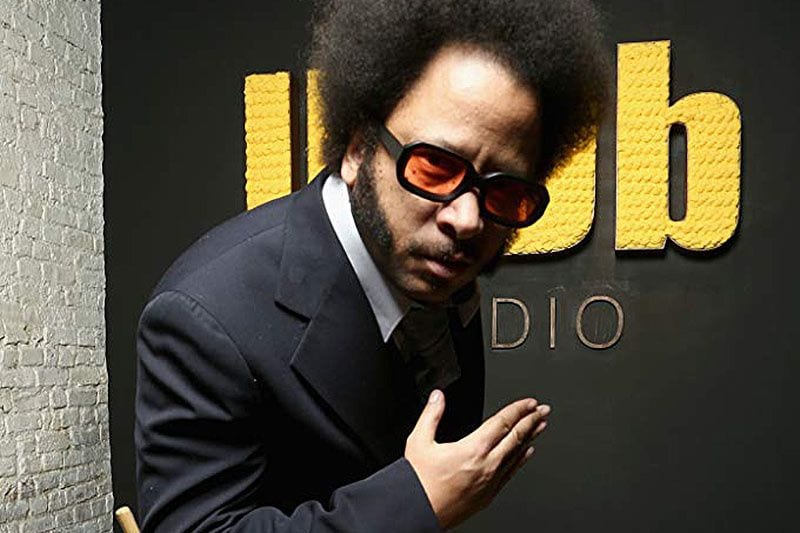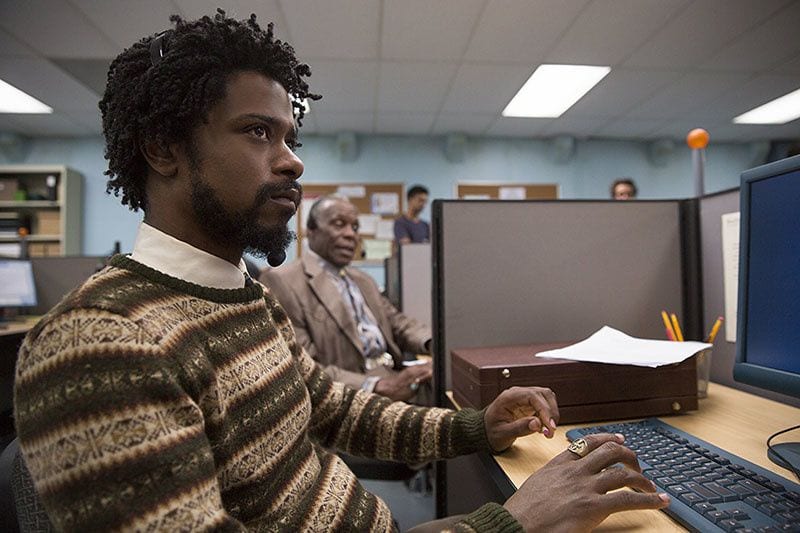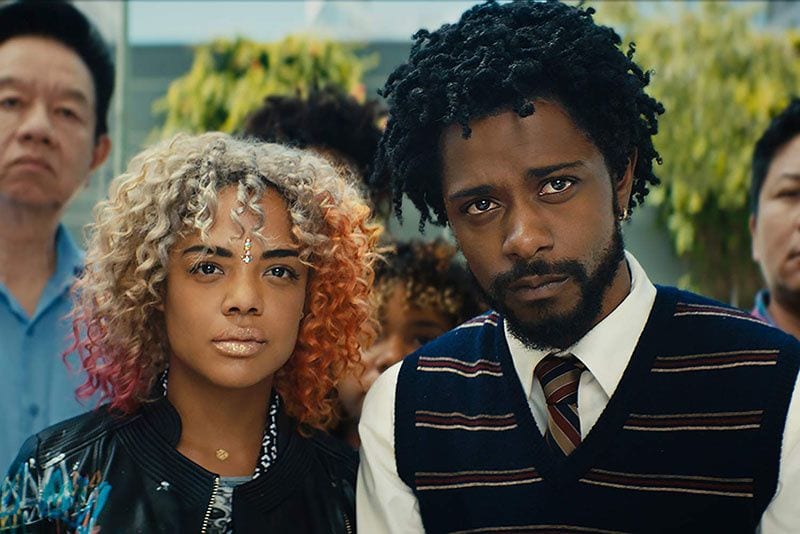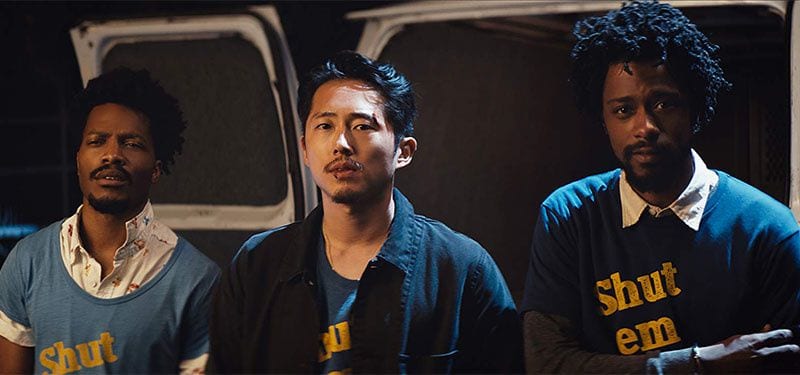Sorry to Bother You is movie of its time. Which is to say, it already feels like it’s late. Funny and angry, surreal and urgent, Boots Riley’s movie takes on the tumult of current crises, wrapping trenchant analyses of class, race, and gender injustices around a spine of comedy and horror. Set in Oakland, California, Sorry to Bother You follows Cassius “Cash” Green (Lakeith Stanfield) as he begins a telemarketing job at a shady company called RegalView.
It’s not long before his coworkers — including his friend Salvador (Jermaine Fowler), his artist girlfriend Detroit (Tessa Thompson), and union organizer Squeeze (Steven Yeun) — undertake a labor stoppage. This while Cash gets a promotion because he’s so very good at telemarketing, selling people things they don’t need, because he’s able to affect a completely alarming “white voice”; that is, a voice premised on privilege. As Cash makes money, he’s increasingly at odds with his friends and privy to RegalView’s monstrous exploitations.
Best known as the frontman for the Oakland-based activist hip-hop group, The Coup, Boots Riley brings his social horror film to screen some six years after the group’s album of the same name (Epitaph, 2012). When PopMatters sat down with Riley, he shared his thoughts on his first movie, history, and the art of radical politics.
Sorry to Bother You uses structures familiar from hip-hop, like collage, clever (visual) rhymes, and vivid imagery. Please tell us about your approach to structuring the film, and your sense of your influences.
The Coup’s early stuff was very much me editing out my influences, with this idea of “This is what people expect.” I didn’t always give exactly what was expected, and I did have other influences that still snuck in there. After the first album, I just let whatever hit me, hit me, whether it fit or not. The main idea is that I need to be passionate about the project. I mean, I need to be passionate about something else more than I am about art, and then be able to channel that excitement into the art.
With the film, there are all sorts of influences, for instance, literature. It borrows from some of my favorite writers, magical realism writers like Gabriel Garcia Marquez, Toni Morrison, Michael Ondaatje. Instead of saying, “He walked to the store,” they might say, “He slowly sauntered to the store, holding in his right hand a coffee cup that, 20 years before, his grandmother used to murder his grandfather. It was the coffee from last night, stale, but soon to be drunk, because he said he would.” You know, the film version of that, the producer might ask, “Why do you have that in there? Just show him at the store.” I think all those [descriptions] tell you more than just those things they talk about. They tell you so much about that character, without needing corny dialogue. That was the sort of style that I wanted.
I’m influenced also by a lot of types of movies and disparate forms. I think that’s what makes new flavors. To get to the new, though, you need to be aware of clichés. I find that the default people have when they’re creating something is often cliché. That’s because, when you’re making a world, whether it’s in a song or a movie, what you use is too often not based on your experience. You use what you know based on other films you’ve seen or other songs you’ve heard.
For instance, I don’t know what Delhi looks like, I’ve never been to Delhi, but I have a picture of it in my head, of buildings, of clothes that people are wearing, of streets. And these ideas don’t even come from documentaries or news photos. They come from James Bond films, and these clichés might have a lot of racist elements. I’m always having to interrogate myself, to ask, what is my experience of the world?
People not [interrogating themselves] is why we have so many independent and blockbuster films built on clichés. What gets edited out is any form of rebellion, even though it’s going on all around us. It’s something that we don’t think of as the world, because we picture our world [as what we see in movies.]
How does your experience shape the unusual scenes in the film, for instance, the crash-down scenes, when Cash is making a call from the call center and the scene takes him to the house he’s calling?
When I imagine Cash is sitting in a call center, I ask myself what do I think about these things? How do I get away from clichés? When [other films] show a split screen of someone talking, what are we missing from that real experience? It serves its purpose of telling us that two people are talking, but what are we missing? The crash-down thing shows the particular relationships of the phone calls. I could get those things out by dialogue, like the guy could say, “You’re interrupting our dinner,” but I’d rather show that feeling instead of telling it.
For me to make it real, I need to put my ideas about the world in there. I could make some sort of corny dialogue, I could make some sort of trial and tribulation that the character has to go through to make you feel empathy for that character, but that also gets clichéd, and creates a separation. I found that the reality of the world I create helps people draw parallels to their own experiences, keeping them close with the character.
Part of what helps us keep close are the extraordinary visual details in each frame.
In trying to make the world real as I see it, and dealing with these themes all the time, the aesthetic comes first. The content is connected. I know plenty of artists whose content I agree with who I think make shitty art. They think that what they’re saying is enough. It sounds weird to say it, because of all the fantastical elements in this film, but the idea is to make the world feel real, and along the rules of how I think people respond to things.
How does this aesthetic help to make the film’s compelling case against capitalism as we know it?
As I’m focusing on rebellion, I’ve got all these people who you don’t usually see, working for change. Historically you see, since the ’60s, what we see as movements for social change are really based around spectacle, around making a statement. Thirty or 40 years before that, before TV, demonstrations were actual demonstrations. You know, “Here are 30,000 people who will shut down your industry.” It was in that milieu that places like Alabama, Colorado, Utah, Montana became what J. Edgar Hoover thought of as “hotbeds” of communist activity. They were shutting down mines, in some places they were having armed conflicts with mine owners, and throughout the Midwest, people were occupying factories.
On the West coast, you had the longshoremen who started their union, even when they were thought of as the most unskilled and un-organizable, the most precarious labor that there was. They made this union and they’re fighting tanks. And in that union, along with revolutions around the world, that’s where we got the New Deal. It wasn’t that everyone agreed with FDR. The strategies of the unionizers were, for the most part, winning: they set out to do something and they caused economic damage.
Before the ’40s, there were radicals advocating for the US to go to war with Hitler. Members of the United Front Against Fascism weren’t going to challenge the US and build for revolution while the US was at war with Hitler. That came back to bite them in the ass because in the ’50s, you have the McCarthy era where they were like, “Look at these people who have been hiding their politics.” That, combined with atrocities committed by Stalin and the CPUSA’s [Communist Party of the United States] non-response to that, made that organization break up into all of these little organizations that became, for the most part, most of the New Left.
That New Left had a different take on things, partly because of news media. It was focused on students, [whose demonstrations were spectacular,] and moved people away from those other areas, stopped working around labor. If you’re going to focus on students, you can’t actually do a work stoppage. You can do a strike that might cause a little economic damage to the institution, if they were a public school. It was focused on spectacle: that was the be-all and end-all, to get people into the streets.
Today, we’re placing lots of hope in televised protests.
We still have that view of social change, which is why people get frustrated about how to make things happen. Even radical progressives and liberals are putting out that idea, that social change happens when the powers that be know that you don’t like something. But we’ve gotten away from the actual point of power, which is at the point of economic exploitation.
So where do we find radical rebellion now?
This is something that we all know, but instead, since the ’60s, radicals have hidden in art — I’m one of them — and academia. Then it becomes about publishing these things, and then you have to say something “new”. You’re saying these new things, you’re looking at different ways to codify things. You say, “Well, I’ve got a different analysis.”
You’re only talking to each other.
Not only are you only talking to each other, you’re also basing stuff not on actual work. Then we get to all these generations of books later, where radicals are arguing over linguistics as a priority. It really comes from an interest in remaining an academic and saying that’s a good reason for what you do. We develop these ways of talking to each other that don’t have to do with what we need to build. Your viewpoint is limited to seeing “Here’s a group of people that use these words,” and “Here’s a group of people who use those words,” and those people are enemies. This is anti-class analysis, because these “enemies” are the people you need to work with to build a movement to get rid of capitalism.
How does this work in Sorry to Bother You?
In the movie, they use the tactic of withholding labor. It’s a tactic that is currently in use by teachers, and the Wal-Mart workers who just a few years ago were met with state militia. You have fast food workers who are interested in organizing. But the SEIU [Service Employees International Union], I believe, weren’t really organizing a real union. To make that work, you’re going to have to have solidarity strikes. And solidarity strikes are illegal, so the movement is not going to be able to be led by an organization that’s worried about the law. It’s going to have to be led by radicals who, instead of going to jail for breaking windows, are willing to go to jail for things. If this were a movement by people who go to jail because they broke the Taft-Hartley laws [a 1947 US federal law that restricts the activities and power of labor unions], like, at least the leadership would go to jail, we’d make a whole different situation.
In this movie, you have the idea that withholding labor creates a different view of possibilities. In another movie, you might have had the same thing, but the goal would be to get a manager fired, not challenge the system fundamentally.
The system persists because of limited possibilities: people are focused on feeding their families. It’s a luxury to not have to work.
And that idea comes from the movies that we see. The movies we consume become part of our view, our sense of what’s possible.
What’s your sense of social media as a means to organize?
I think, hopefully it can work, but it’s not in our control. Even though people are conscious that we’re not selecting what pops up on our feeds, people still believe that how they see what people are concerned or excited about is somehow democratic. We’re so easily manipulated. The blueprint is there. So social media can get the word out about some things, but if there needed to be an invisible wall, it could be easy to make one. The companies are very interested in making that.
It’s a different approach to organizing too. It’s not just, “We can get in contact with people on the street,” and “We can get in contact with people by phone.” If the ways that people are networking are at their places of work, then you can refocus, the movements can be focused through work, people you know at work and at other places of work. That’s not just their social media.
There’s a different stake, when you’re connecting in and through your workplace. Can you talk about how the character Detroit [Tessa Thompson] works in the movie? Her work and her art are urgent and difficult. A key point in the film is her performance piece [Detroit stands on a stage in a bikini, and invites her audience to pelt her with cell phones, bullet casings, and water balloons full of sheep’s blood, while she recites a monologue from Michael Schultz’s 1985 film, The Last Dragon]. How do you see Detroit?
I work with the actors to fill out characters and make them their own. I also wrote each character from my own experience. All the dialogue is like playing chess. What would I say if somebody said this to me? What would I ask if someone else said this? All those main characters are aspects of me as the organizer. There’s the artist, the funny guy, the person who’s trying to figure out what their life means.
I think that Detroit represents that conflict within me, whether art is really doing anything, whether it’s effective, all the hypocrisy around it. Also, add some hope, because what she’s trying to do is paint a vision that people can do something about this.
[Detroit’s] performance is part of that. The Last Dragon is one of my favorite movies. Part of that has to do with the circumstances of my first seeing it. In high school, I saw it in a theater that is a less exaggerated version of the theater that’s in the movie, where Detroit performs. The idea is that we can take anything and put meaning into it. The context is the meaning.
She is doing a similar performance to what Cash is doing. Her performance comes right before Cassius’ performance [he “freestyles” for a white audience at the home of RegalView CEO Steve Lift (Armie Hammer)]. I think that her argument would be that her performance is for a different reason.
I think Cash might make that argument too. He’s upset when he sees her performance, but sees his own as necessary.
You’re right. And the whole film is about performance, about how people see it and use it.





